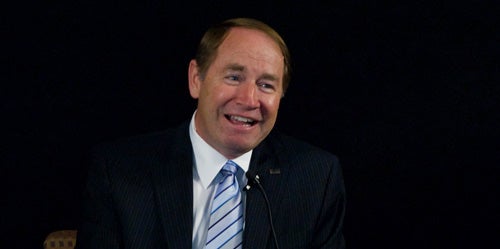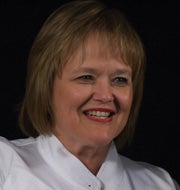President David M. Dooley, Our Newest Big Thinker

“The goal of the modern university is to prepare students for careers that don’t yet exist, using technologies that have not yet been invented, based on knowledge that hasn’t yet been discovered.”
Follow President Dooley’s blog, and more:
Growing up in rural central California, David M.Dooley was fascinated by nature; he spent hours exploring the natural environments of the forests, farm lands, and mountains. Not only did he enjoy the science of the physical world, he discovered later that he loved explaining it to others.
“What I loved about science is that you could understand things from a logical perspective. You could begin to understand why it looked the way it did and how it came to be that way, and you could explain it to others. Providing those explanations fascinated me, and I made the decision that what I wanted to do, ultimately, was to be a scientist and a teacher and devote my life to education,” said Dooley.
This fall, Dooley, 56, brings those lessons learned outdoors, in the classrooms, in the labs, and as an administrator in the boardrooms of higher education to the University of Rhode Island as its 11th president.
“The essence of what we want to do at the University of Rhode Island is to create what we call a community of discovery that encompasses undergraduate students, graduate students, and the faculty and staff. We want to infuse the entire enterprise at the University with the thrill of discovery,” he said during an interview this summer.
Prior to joining the University, Dooley was the provost and vice president for Academic Affairs at Montana State. There he played a central role in the development of the college’s vision, values, and core messages. “My leadership philosophy and style emphasize collaboration as the primary mechanism to foster both innovation and mutual accountability,” said Dooley. “I actively encourage and reward decentralized, entrepreneurial approaches to problem solving and program development.”
 “Members of the entire University community, on and off campus, are excited about President Dooley’s arrival. He brings with him a reputation as a leader who is an effective listener, someone who respects others and their views. His collaborative style means that he reaches out. His decision-making style reflects his scientific background —to collect all the relevant data and do a thorough analysis. While his presidency will lead URI to a greater emphasis on research and the generation of more outside resources, he is also known as someone strongly committed to students. Our student leadership was happy with Dr. Dooley’s selection. They see him as someone who will engage them academically, and in many other meaningful ways too,” said Vice President for University Advancement Bob Beagle, who led the presidential transition and coordinated the community forums with the new president.
“Members of the entire University community, on and off campus, are excited about President Dooley’s arrival. He brings with him a reputation as a leader who is an effective listener, someone who respects others and their views. His collaborative style means that he reaches out. His decision-making style reflects his scientific background —to collect all the relevant data and do a thorough analysis. While his presidency will lead URI to a greater emphasis on research and the generation of more outside resources, he is also known as someone strongly committed to students. Our student leadership was happy with Dr. Dooley’s selection. They see him as someone who will engage them academically, and in many other meaningful ways too,” said Vice President for University Advancement Bob Beagle, who led the presidential transition and coordinated the community forums with the new president.
Earlier in his career at Montana State University, Dooley led the university’s Chemistry and Biochemistry Department and served as a professor of chemistry and biochemistry. He had been a central figure in attracting research dollars to Montana State, helping to grow that budget to $100 million during his tenure. MSU is now ranked among the top tier research universities as classified by the Carnegie Foundation for the Advancement of Teaching. URI, which is ranked in the second tier, aspires to that goal.
The new president wants URI to be known as a university with a record of excellence in both undergraduate education and in research and scholarship. To Dooley, the integration of research and undergraduate education is “not a tag-line, not a one-time sound bite.” It is a fundamental value.
“How we conceptualize undergraduate education is to think of it as preparing students to participate in and provide solutions for the big problems. The goal of the modern university is to prepare students for careers that don’t yet exist, using technologies that have not yet been invented, based on knowledge that hasn’t yet been discovered,” he said. “In order to ready students for that future, we have to do more than simply engage them in the classroom.
“When freshmen arrive we should be able to say—regardless of your major—if you want to be part of the solution to things like the global health crisis, poverty, climate change, or preserving peace and building a sustainable world, here’s how you can get started on that agenda.”
Dooley was pleased with how much of URI’s work in the humanities and the social sciences already interfaces with the sciences and engineering. “The humanities, especially the public humanities and the development of public policy and public awareness, inform us of who we are and where we’re going and how science, technology, and other ingredients may impact our future,” said Dooley.
He stated that this means actively creating opportunities for students to engage in research and creative work.
“In the arts, students need to be given the experiences that enable them to develop their artistic talent, their creativity, to give it expression. We will need to provide them mentorship and direction so that they can develop their creative vision as undergraduates because they’re going to need that when they leave the University,” he said.
Actively engaged in teaching and research throughout his academic career, Dooley maintained a laboratory with research funded by the National Institutes of Health and the National Science Foundation while he was provost at Montana State. Both research projects examine the role of metals like copper and iron in biology.
In the NIH research, he is investigating a series of copper-containing enzymes and learning how they may relate to disease and health in humans and other organisms.
In his NSF-funded research, he is studying a global environmental cycle, called the nitrogen cycle, and the role of copper- and iron-containing enzymes in the cycle. “We want to understand these enzymes and their reactions within organisms and relate them to scientific questions that are important to understanding how the planet works,” he said.
At URI he hopes to collaborate with scientists who might be exploring some of the same questions and who involve undergraduate and graduate students as active participants in their research.
“What makes a university special as a research university is that research encompasses all of the activities of the institution. We are looking for every opportunity for undergraduates to be involved in research and creative work. I think that’s an essential component of a competitive undergraduate education that will prepare the students to fulfill their dreams and aspirations.”
Dooley says that for the University to be successful in all of these endeavors, there needs to be a strong sense of community and commonality with regard to goals and visions. And he knows that those are traits that must be developed.
“You’ll never get unanimity on a university campus about anything, except perhaps—perhaps—that the sun does indeed rise in the east and set in the west and a few other basic facts. Outside of that, aiming for unanimity is probably hopeless, but aiming for broad consensus is not.”
An avid outdoorsman, Dooley believes students should be encouraged to be active outside of the classroom and laboratory. “We know very clearly now, scientifically, that the health of the body is very important to your success intellectually, your longevity, and your ability to have the life that you want to lead. We want to provide opportunities for our students to explore and become passionate about physical activities.
“I played a lot of intramurals as an undergraduate and enjoyed it. Then when I was at Amherst College, I played on a club rugby team as a faculty member. At 26, I was young enough so that I could still keep up with a bunch of 18-22-year-olds. I was fast, so I could play wing, which meant I didn’t get beat up too much.
“We need to facilitate student access to activities like rugby, hockey, lacrosse and all the other club teams that we have at URI,” he said.
Though you may not see him on the field now, Dooley says he loves being outdoors climbing, hiking, and walking. He said he also plays golf and looks forward to sailing.
“I play golf badly, but I have a great time doing it, and I understand that as the University president, it’ll be incumbent upon me to improve my golf game—and I’ll work on that!”
While he laughed when he said his summer reading list didn’t rival The New York Times’ list, the book Density Functional Theory, a Guide For Chemists, topped his list along with books on philosophy and western history.
Since starting at URI in July, Dooley has held a variety of meetings with senior leadership and key internal and external groups. His active fall schedule includes speaking engagements and media interviews throughout the state.
In August, Dooley traveled to Japan to speak at two scientific meetings. While traveling, he kept in touch with the University community in a new way: his blog, the first by a URI president, accessible from the University’s home page, as well as from the president‘s Web site.
His first blog post on July 28 shared his enthusiasm: “There is just something special about coming to work at a place that has the word Hope emblazoned on its seal.”
–By Jhodi Redlich ’81
Photos by Nora Lewis
 Home
Home Browse
Browse Close
Close Events
Events Maps
Maps Email
Email Brightspace
Brightspace eCampus
eCampus



